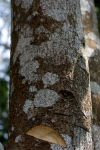
TEJA
SCIENTIFIC CLASSIFICATION
Kingdom : Plantae
Class : Magnoliopsida
Subclass : Magnoliidae
Order : Laurales
Family : Lauraceae
Genus : Cinnamomum
Scientific name : Cinnamomum iners Reinw. Ex Bl.
Synonym name : Cinnamomum eucalyptoides T. Nees,
Cinnamomum nitidum Blume,
Cinnamomum paraneuron Miq.
Local name (Vernacular name) : Medang Teja, Medang Kemangi, Teja Badak, Teja Lawang, Kayu Manis Hutan
English name : Wild Cinnamom
Othes name : Keningau, Mandiapa, Medang (Borneo)
DISTRIBUTION
Thailand, Peninsular Malaysia, Sumatra, Java, Borneo (Sarawak, Brunei, Sabah, West-, Central- and East-Kalimantan), Philippines.
In undisturbed to slightly disturbed mixed dipterocarp and sub-montane forests up to 1400 m altitude. Mostly on hillsides and along rivers. In heavily disturbed secondary forests usually present as a pre-disturbance remnant tree.
CHEMICAL CONTENTS
- Leaf
Saponin, terpen and oil. The contents of oil are eugenol, terpen and sinamic aldehid
- Root
Saponin, terpen, eugenol, sinamic aldehid and safrol.
- Bark of stem
Alkaloid, saponin and terpen.
- Stem
Saponin and terpen.
MORPHOLOGY
- Diagnostic characters
Leaves pink when young, glaucous beneath with three longitudinal veins, crushed fresh leaves  and inner bark with strong smell of cinnamon. Fruit green with yellow spots when young, dark blue when ripen, calyx lobes present.
and inner bark with strong smell of cinnamon. Fruit green with yellow spots when young, dark blue when ripen, calyx lobes present.
- Habit
Evergreen tree 20-30 m. tall. Crown bushy rounded. Sapwood whitish.
- Trunk and bark
Trunk straight, bark smooth and lenticellate, greyish- brown, inner bark pinkish with strong fragrant smell.
- Branches and branchlets or twigs
Twigs brownish sparsely lenticellate.
- Exudates
Exudate absent.
- Leaves
Leaves simple, opposite or sub opposite, 7.5 - 30 by 2.5 - 9 cm. oblong to elliptic, apex pointed, base usually cuneate, margin entire, blade leathery, slightly brownish when drying, glaucous above, glabrous on both side.
Three main veins flat above, proeminent below, secondary veins obliquely closely percurrent to midrib. Petiole  with very short hairs.
with very short hairs.
.
Flowers grouped in terminal or axillary panicles, bisexual, flowers with unpleasant smell.
- Fruits
Fruit is a berry, ellipsoid, 1 – 1.5 cm, long and 0.6-1 cm, wide, dark green with yellow spots, blackish-violet when ripening, calyx lobes present.
- Seeds
One large seed.
ANATOMICAL DESCRIPTION
- Venation
Main venation close, free-ending vienlets few, unbranched; marginal venation fimbriate
- Epidermis
Adaxial anticlinal walls thick and wavy, abaxial anticlinal walls wavy; stomata anomocytic
- TS Lamina
Adaxial and abaxial epidermis as high as wide to 11/2 times wider than high, thick walled, outer wall of abaxial epidermis convex; hypodermis nil, palisade in 1 layer, spongy mesophyll 4-5 layers of cells, sclereids nils, crystals: acicular in palisade and spongy mesophyll, oil cells in palisade and spongy mesophyll; trichomes simple, unicellular oriented horizontally.
- TS Margin
Pointing slightly downwards, slightly tapering, sclerenchyma at edge
- TS Midrib
Outline: adaxial surface convex, abaxial surface arc-shaped. Ground tissue: sclerenchyma cells below adaxial and abaxial epidermis. Vascular tissue: open type, arc-shaped, sclerenchyma sheath nearly continuous, the adaxial part continuing into sclerenchyma below adaxial epidermis. Trichomes nil, iol cells in parenchyma tissue; crystals: acicular in parenchyma cells.
- TS Petiole
Outline: adaxial surface nearly straight, abaxial surface rounded; outer tissue: brachysclereids in ground tissue, parenchyma cells with yellowish content; oil cells abundant near periphery of petiole. Vascular tissue open type, arc-shaped, sheath absent, thick-walled fibres/sclereids in phloem; trichomes simple, unicellular occasionally seen; crystals: acicular and styloid in parenchyma cells.
USES AND PRODUCTS
- Wood
The wood is used to make joss sticks, and as a medicine against fever. As a spice it is extremely variable in quality.
- Timber
The timber is insect resistent and used for house building and cabinet work
- Leaves

 Leaves are used for preparing sweet drinking water in rural areas.
Leaves are used for preparing sweet drinking water in rural areas.
- Various parts
Medicinally various plant parts are used for child birth complications, fever, rheumatic poultice,and to relieve flatuence, intestinal and urinary complications.
- Bark
The bark yields an inferior grade of cinnamon but oil distilled from it and from the leaves can be used for flavouring and for incense sticks.











